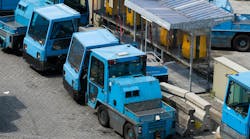Roeth: Battery-electric terminal tractors have proved they can do the job
It’s not often a technology is a perfect fit for a job. By perfect fit, I don’t mean there are no challenges with deploying the technology but rather that the challenges can be overcome with some planning and training.
I think battery-electric powertrains are ideally suited for terminal tractor applications. Have you heard of terminal tractors? Some of you may not have heard of them, or you may have heard them called by not-so-glamorous names like yard dogs, goats, mules, etc.
Consider this: Terminal tractors typically see very few miles each day, stay close to their base, and don’t operate at very high speeds. Keeping terminal tractors close to base allows them to take advantage of opportunity charging, which means they can be plugged into the charger when the driver is on break or at lunch.
Another big plus is that electric units can be a direct one-for-one replacement for all diesel-powered terminal tractors with little to no adjustments to operational practices needed.
Battery-electric terminal tractors are a great way for fleets to get comfortable with the new technology because of the nature of the duty cycle and the fact that many firms already have experience using electric material handling equipment. For those that have electrified their material handling equipment, battery-electric terminal tractors are a great next step.
See also: Schneider adds electric terminal tractors to SoCal fleet
Three of the 13 vehicles that participated in Run on Less Electric in 2021 were terminal tractors from different manufacturers: Kalmar Ottawa, Lonestar, and Orange EV. We also tracked an Orange EV terminal tractor at OK Produce during the recent Run on Less Electric – DEPOT. As a side note, Orange EV recently delivered its 1,000th battery-electric Class 8 terminal tractor. That’s a lot of trucks.
Even though battery-electric terminal tractors have a higher initial purchase price—which is one of the challenges—fleets are finding that their benefits, especially when factoring in driver acceptance, make them an attractive option. In fact, several fleets that have invested in terminal tractors say their trucks are performing so well that they will never purchase another diesel-powered terminal tractor.
By using terminal tractors, fleet personnel can become familiar and comfortable with battery-electric vehicle technology and become better able to understand some of the issues surrounding a move to battery-electric vehicles, including site readiness, selecting and installing electric charging infrastructure, and training drivers.
If you use terminal tractors, I strongly suggest making your next one electric. I expect you won't regret it.
Michael Roeth has worked in the commercial vehicle industry for nearly 30 years, most recently as executive director of the North American Council for Freight Efficiency (NACFE). He serves on the second National Academy of Sciences Committee on Technologies and Approaches for Reducing the Fuel Consumption of Medium and Heavy-Duty Vehicles and has held various positions in engineering, quality, sales, and plant management with Navistar and Behr/Cummins.




